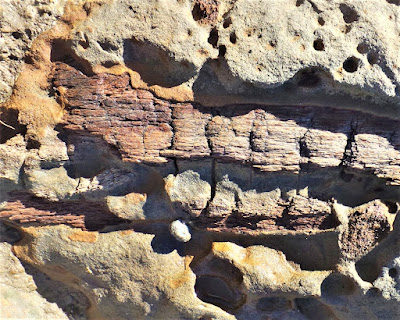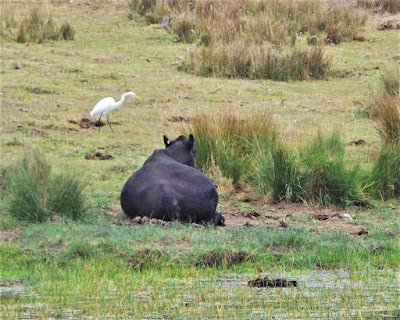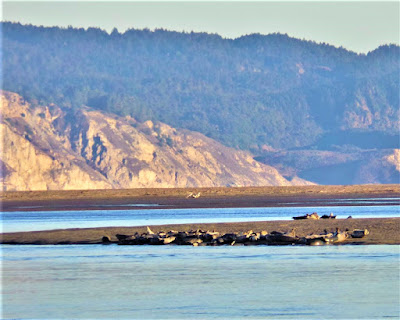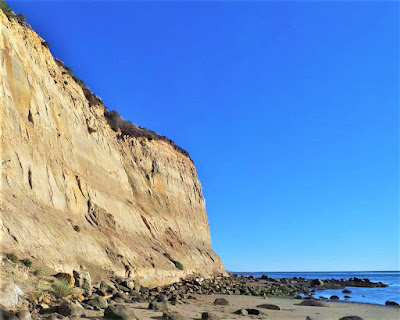POINT REYES NATIONAL SEASHORE: Tantalizing Discoveries, Uncanny Phenomena & Frivolous Diversions at Sunset Beach

You drop your bikes at a small pond to catch your breath and wet your whistle, giddily sniffing in lungfuls of sweet ocean-scented air.

Still a few clicks from your mondo ocean destination – a rugged and isolated spit of Pacific coastline along Drake's Estero called SUNSET BEACH! – you're in no special hurry to "make time." Only kill it, slow-baked and leisurely over the course of the next several hours waiting for the sun to go down.

Sheltered within a 1300-acre marine sanctuary in remote Point Reyes National Seashore, the Estero's six perennial creeks drain a pristine 7847-acre watershed – an estuarine / coastal / foothill biota unrivaled on the West Coast.

(Years of legal wrangling later, an oyster company recently got the boot, while cattle grazing is allowed to continue, a worse defiler of natural habitat and offender of aesthetic nature experiences than oyster farming. The science attests to the benefits, though, you've read, so what are ya gonna do?)

Named for the 16th century picaroon / privateer, Drake's Bay / Estero was the putative layover for the Golden Hind, a propitious landing spot providing hearth and provender for several months while Sir Francis repaired his ship, damaged during attacks against Spanish Armada West Coast ports in service of Queen Elizabeth I's "special ops" forces operating against King Philip II's aggressive marauders.

Military forays – make that raiding and plundering expeditions – were carried out up and down the coast between the two mortal enemies each desperate to establish a permanent foothold – and seize the most bodacious booty – luxury goods, gold, silver, porcelain and spices coming up from Acapulco – in the name of the Imperial Crown.

Note to self: wait, now, who were the good guys again, you keep forgetting?


You wonder, did the crew / natives miscegenate? Not according to Oliver Seeler, who debunks much of accepted knowledge about Drake's activities and whereabouts. On this topic, he asserts:

" . . . there is no evidence that any sexual contacts, permissive or otherwise occurred."

Yet this sort of puritanical discipline on the part of sex-starved sailors you find hard to believe in a day and age when forced sexual liaison (i.e., rape) was the norm in the ranks of conquerors and oppressors. (Still might be.)

Well, who knows, you don't, maybe it is an outlier case in history of an example of sustained peaceable relations in a First Contact setting. Most likely, it'll never be known what exactly took place, how things went down, amiably and convivially, somewhere in between, or otherwise.

No question, though, it was some kind of paradise . . . soon to be lost forever, at least for the unassuming Coast Miwok (maybe Pomo) who greeted the Spaniards bearing gifts and carrying no weapons.

A peaceable people who regarded the interlopers as Gods, they also by nature were an overly friendly and trusting lot, prone to be taken advantage of and easily duped.

But in an interesting twist, Seeler recasts Drake's Weltanschauung as atypically laissez faire and polite, compared to the behavior of contemporaries elsewhere engaged in the brutal and systematic Old World takeover of the New World.

Seeler writes of Drake's treatment of the natives as standing:

" . . . in sharp contrast not only to the later tragic destructions of native cultures, but to common practices of the day."

(While admitting to self-serving / ulterior, non-altruistic motives, which c'mon, had to be the case more than their benign cultural relativism!)

Okay, all fine and good, but let's get real, it was all downhill from the get-go. These and other first contact encounters set the stage for a centuries-long church / state sponsored campaign of subjugation, slavery, cultural disintegration and genocide.

But, hey, in the beginning bonhomie (apparently) prevailed between the Curious Indigenes and the Good-Intentioned Visitors – a motley crew, for sure, merely strange mortals, let it be known, but perceived by the natives as Gods manifest. You wonder how long it took for them to wise up.

Enough with (pseudo) cultural history; now for a bit of (quasi) natural history. The Great Estero's fresh and saline waters, you only learn later, intermingle to create optimal conditions that support diverse sea dwelling creatures and creatures that depend on the sea to dwell.

A fine sandy substrate helps shape the tidal / marsh environment, giving rise to an essential plant you'd never heard of.

Eelgrass!

Thank heavens for eelgrass!

Like the resident apex predator (Harbor Seals), eelgrass is a linchpin species, crucial to anchoring the Estero's fluid food chain and web of life, providing cover, sustenance and breeding habitat for fish and invertebrates.

The National Park Service considers eelgrass to be:

" . . . highly significant to the ecological function of the estuary."

Note to self: and here thought you knew everything!

Harbor Seals come and go and feed and play and rest and breed in large numbers and with particular nursery preferences. You're amused by their round furry brown heads bobbing on the water's surface, so curious at your presence (you think).

With eyeballs peeled, if lucky, you might spot bat rays or leopard sharks tooling around in the clear shallows, whilst a spectrum of "insignificant" aqueous and earthy creatures operate unseen and hidden, "mean and lowly things" vital to the ecosystem's health that Aristotle insisted we must grok in order to understand the world itself.

The Estero's biodiversity attracts migrating birds who winter over (or spring over), flocking in numbers too large to count, feasting on the Estero's propitious food chain ingredients. The area offers up some of the best bird habitat around.

On the other side of the bluff, Limantour Beach gets all the attention, ornithologically speaking, but along the Estero's inland bays, hundreds of birds, some rare, threatened and endangered, come together in a great feathery biomass.

Cormorants 300 strong; coots, ducks and other shorebirds in uncountable aggregations; pelican and gull klatches; a mirage of sandpipers in mesmerizing murmuration, a single organism skirting across the surface of the bay.

All quite hard to pull away from, your chill spot with such great views and all the bird activity. Something catches your attention in a far away tree top. A quick check through binos reveals an American Kestrel striking a statuary perch, adorned with distinctive facial marks and possessed of a taut, strong diminutive body.

One helluva huntress, Kes is the first of four raptors spotted today, along with a Northern Harrier, a White Kite and several Red-tailed Hawks, but Merlins, Ospreys, Goshawks and Peregrine Falcons go unseen.

The Kestrel suddenly lifts up and takes flight over a sloping meadow, crossing paths with a pair of Red-tail Hawks who begin engaging and dodging a gang of crows flying over, setting off a flurry of screeching and evasive aerial maneuvers.

The biggest crows you've ever seen, and outnumbered five to one, the Red-tails want no part of 'em.

Across the pond, two creatures appear out of the dissipating fog, spooky figures that turn out to be foraging deer. Opposite, on the pond's skanky hoof-trampled edge, a Great White Heron stands frozen, in crouch mode, on spindly stilt legs, immobile as a rock, a caliginous sculpture of zen patience, hidden to all the world.

Except you (and the cow).

No doubt about it, this is one splendid ass day at Point Reyes National Seashore, biking Estero Trail to SUNSET BEACH, eliminating nine miles of hiking which your ever-sore ankle would not withstand. Tomboyishly, you delight in the day's simple adventure, but exotic prospect – chewing up a heaven's worth of coastal foothill scenery.

You're skirting the pretty headlands of Home Bay, barreling along like mad men for the most part, churning and burning up some of the trail's tougher hill stretches. Final destination: SUNSET BEACH! You are, quite simply and exotically, enjoying one splendid-ass day at Point Reyes National Seashore.

You ditch your bikes in the thicket at the Estero / SUNSET BEACH! Trail intersection and hike the remaining mile or so. It feels so damn good to be walking!

Last time/first time on this stretch with Gambolin' Gal, plop out of the sky, a half-eaten hare fell to the earth a few minutes before, fresh guts exposed, trailkill waiting for a vulture or coyote to claim, or the hawk that dropped his prized morning victuals.

Note to self: how does a hawk express an "aw shit" moment?


The recondite island group – you've still never been! – is protected within the San Francisco Bay National Wildlife Refuge, part of a larger National Marine Sanctuaries system of special oceanic conditions and undersea topography along a 150 mile stretch of historic Bay Area coastline.

Whoa! SUNSET BEACH!

It just might be the prettiest and least known and scarcely visited beach in the Point Reyes National Seashore system of pelagic jewels. A lifetime's worth of first impressions quickly sear in your brain of a wild, alluring, transcendentally beautiful place.

A supernal seascape, but also a brutally exposed world, with scant respite for shade, a world where sleeper cell harsh elements can – and will – turn on you at any time, posing unsuspecting hazards and unseen peril.

Note to self: check all hubris at the door.

Arriving in the crisp glare of a winter's noon affords plenty of time to burn until the pyrotechnic show begins to glow at 4:53 PST, the official sunset. So how do you pass five hours out here "doing nothing" under a bright and penetrating sky?

Easy, is how.

The hours slip by unnoticed, filled with fun and frolic, that's how badly you want to see this day out and bear witness to, as few are fortunate to experience, a quotidian but hardly pedestrian event: the sun going down at SUNSET BEACH!

You are there! You are here!

SUNSET BEACH!

And let the games begin!

The rocky beach is all yours, a narrow strip of unreal estate sandwiched in on one side by the sea and on the other by impressive alabaster cliffs rising a hundred feet high and turning Egyptian gold in the late afternoon gloam.

You've seen a total of zero people, well, except for a lively "older" couple who head back early and another guy hanging around looking for polished sea glass, it's been a total of zero.

You're held captive by an infinite variety of natural distractions at hand (and foot), spawning a zillion questions and observations. Like wide-eyed Hardy Boys set loose in some fairyland playground, you find everything in your path amazing and worthy of deep analysis.

You take a whole friggin' half an hour practically to walk a mere fifty feet, marveling at every single little odd-shaped stone, entranced by mystery sea lion moans, and thrilling to discoveries of fossilized whale bones.

Who knows in this fantabulous land, maybe you'll turn up a Unicorn's horn next. And so you dawdle away the hours of a seemingly endless day, expostulating and pontificating on any number of subjects hatched in your imaginations by the wealthy array of things to investigate and big question conundrums to chew on.

A real heady cud of natural history, science, paleontology, philosophy – one of you, after all, is a scientist – singularly possessed of boundless curiosity and unending glee – just like little boys – over the simplest – and most complex! – of things.

Operating in a heightened state of awareness fueled by a dopamine flush and endorphin high, a hyper-attention OCD-like mindset takes hold, in which natural phenomena assume exaggerated importance and take on an aura of immense mystery and interest:

IN EVERY LITTLE THING!

In this supernal world, nothing is as it seems. Natural features take on animated personalities. Objets trouvés turn up you want to take home (but don't). Funny faces look out from rocks – some work, others fall flat. Rock faces holding eons of secrets.

You are most definitely flummoxed, baffled, and bemused in a way that sends frissons of joy from one chakra up to the next, until your brain is lit afire like the coming sunset extravaganza.

Artfully arranged strands of beached eelgrass. (Befitting a MOMA installation.) Anemones clustered like ploopy drupelets on a humpback round rock. A dragonfly design inlaid on a rock.

A polished flipper bone and other skeletal remnants of seals victimized by Great Whites.

Notably absent from last time / first time is the seal skull you found positioned on a rock.

Gigantic log thrones claimed by enormous crows as bully pulpits. Mud crabs scurrying for cover. Blubbery ass seals zoning out on sand bars. Oddly sculpted rocks taking on the appearance of apes, turtles, and other bizarre imagined zoomorphic figures.

And without a doubt, the highlight of all your aimless (but purposeful) beachcombing is finding several outstanding specimens of ten-million-year-old Cetacean fossil bones and halibut vertebra!

Hard to top that!

First time/last time with Gambolin' Gal, you failed to spot the fossil whale bones, or so you thought, because you'd been scanning the high cliff faces looking in vain for embedded skeletal remains.

Which is a ridiculous assumption, for the fossil bones are – hello! – not on display in some paleontological panel on the cliff face, with fully articulated or recognizable skeletal structures – no, they're scattered willy-nilly up and down the coast, here, there, everywhere you step, fossil specimens nearly indistinguishable from regular sea rocks.

That is, until you take a second, harder, closer look.

Note to self: first time/last time you actually did photograph the fossils without realizing what they were at the time!

The next couple of hours are passed with particular attention focused on keenly inspecting every rock with a plausible fossil look to it, delighting in noting ossification patterns and other tell-tale clues to an osteological origin.

How funny, though, at first, you think it's fossilized wood, debating one another how this could be so, but obviously it must be so, because, just by looking, it's obvious, seeing is believing, and – just look! – the specimens sure as hell look like fossilized wood!

Note to self: very similar, but yo, a tree is a tree and a bone is a bone.

Around 4:30, as the day is waning, you strike up a conversation with a search and rescue guy digging around meticulously in the sand for polished glass. Just you three lonely humans out here at the edge of the world. He's an amateur naturalist who sets you straight.

Ain't no petrified wood in these parts, guys.

Them's real whale bone fossils!

Then he points out a couple of small, petrified protrusions in a rock. If you didn't know what they were, you might mistake them for insignificant accretions or natural oddities instead of ancient halibut vertebra.

Dude also somehow manages to turn up a small, curved piece of reticulated bone, more halibut vertebra who met his fate here millions of years ago when this was all under water.

By now, the tide has receded dramatically, exposing a fantastically fractured seabed whose huge reduction in water volume (oddly) recalls in your mind the old tale of the Five Chinese Brothers and the one who could swallow the sea to reveal all the riches of the deep blue laid stark and bare.

With the tide a good ten feet out, tidal pools, curiously absent of starfish, appear, and once submerged rocks rise like little volcanic islands. Glistening mud patterns ripple in beautiful psychedelic patterns.

With always one more bend to look around, you boulder hop carelessly on slippery rocks and fall on your back with a wicked thump, shaken but not stirred. Moments later, on cue, your other half stands too near to the edge of a brittle chunk of seabed, breaking it off, sending him awkwardly into the tidal pool, luckily unhurt.

Note to self: any number of things can do you in and mess with your day . . . you do not want a swollen ankle out here, or a deep gash, or worse.

Finally, the bright and endless day begins to give way to a softening effect. The late afternoon lighting is blessed with a crispness and clarity that seems 3D virtual, hyper real, a delicate interplay of light, shadow and substance, a tapestry of lacquered water and pastel brushed sky, a tableau of fractured rock and unending sea.

An almost frighteningly vast, unfamiliar world existing of its own accord, accountable to nothing and no one, operating on its own terms, by its own rules, in its own time and eternal and infinite rhythms.

Note to self: a venue to trespass respectfully, but not a place of permanence for a puny human.

You are there! You are here!

SUNSET BEACH!

AT SUNSET!

Nowhere else you'd want to be on the entire planet!


Plus, you're experiencing an ever so slight sensation of malaise, having forgotten how vulnerable it feels being out at an uncommon hour, alone in the wilderness, far from the trailhead, in the dark, surrounded by contorted shapes and unfamiliar objects, haunted by mysterious sounds, engulfed by dark voids.

All quite unsettling, but the raw experience and exhilaration trumps so you stick around to savor for several more minutes the holy loving crap out of – this special present moment – cold and darkness can wait.

More than several minutes pass, though, and now it's really time to break free from the magnetic attraction. You gear up, ready to high-tail it back like nobody's business, but, alas, you're still unable to pull away, not just yet.

You pause for several more double takes, each a prolonged last lovelorn glance, one final melancholic encore to salute the surreal act's final curtain call.

The knife-sharp contours of the Point Reyes peninsular ridge is bathed in fiery pastels, a bold silhouette against a spotless indigo sky, a heady peyote vision splattered with hot lavenders, incendiary reds, sensual yellows, passionate purples, and heartmelt blues.

The Great Estero's sunken waters brim in reflective brilliance, exposing arterial creeks snaking like makeshift rivers into Drake's Bay.

Not an everyday sight, so you stand steadfastly, holding your ground, refusing to turn your back, gawking, mind-blown, with the minutes ticking by and the scene becoming darker and more – portentous? – by the second.

Time to get a move on, Hardy Boys!

At the crepuscular hour, the animal show intensifies. The signature call of a Great Horned Owl – a high-pitched hoo-hoo-hoooo! – pierces the silent night. Just enough light remains to make out a pair of the regal birds perched on twin fence posts up the hillside.

Hoo-hoo-hooooo! Hoo-hoo-hooooo! Hoo-hoo-hooooo!

They exchange calls, ready to launch a fearsome zipline assault on a hapless vole out for a paranoid stroll. One owl flies off, the other stays put, emitting a series of eldritch hoots that send frissons down your spine.

With high-powered headlamps you navigate safely back to the trailhead, but not before stopping in your tracks at eerie ululations reverberating in the dead of night – a pack of coyotes making their way somewhere, their plaintive yips echoing like lost banshees.

Then, in the middle of nowhere, a pair of beady glowing eyes fixates on you like laser beams twenty feet distant. You freeze for a moment, wondering, but luckily, the wild animal turns out to be a harmless old bobcat, and not the other feared feline predator.

Note to self: what would you do, besides shit your pants?

You roll on slowly by, without incident, as expected, since no bobcat has ever attacked a human. (Sigh of relief.)

Lickety-split, you're back at the car, pitch darkness prevailing, bright moon unrisen still, adrenaline-rushed at being back safe and sound. Oh, and dead tired. With just enough energy left in the tank to load the bikes and change clothes. Before stopping suddenly to look up at the Milky Way, the Greatest Show Off Earth!

The best you've seen the dense stellar cluster since a night in the Sierra Nevada mountains years ago, or maybe it was below sea level in Death Valley. Scanning the heavens of an infinite universe, being a speck of a speck of cosmological insignificance, but so what – you are still part of it all, the "stuff of stars."

Just a few more moments to gawk and admire the sidereal show of the dense cluster of stars at the center of the galaxy, one last curtain call, paying mute, exhausted homage to it all.

From the watery wilderness of SUNSET BEACH! to the sparkling other worlds, unreachable and inscrutable, above and beyond the (no less wondrous) terrestrial realm of SUNSET BEACH! at Point Reyes National Seashore.

LONG MAY THE SUN RISE AND SET AT POINT REYES NATIONAL SEASHORE!

Read more posts from Gambolin' Man on the incomparable and magnificent Point Reyes National Seashore:

Kick back and enjoy 22 videos of various scenes filmed on location at Point Reyes National Seashore:



1 Comments:
Amazing, as usual.
Post a Comment
<< Home